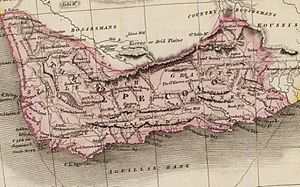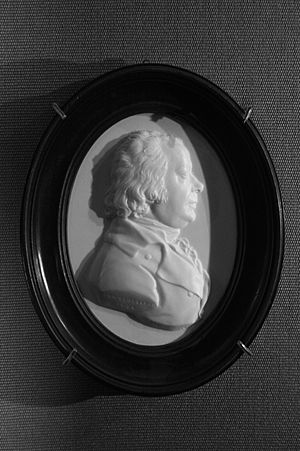John Pinkerton facts for kids

John Pinkerton (born February 17, 1758 – died March 10, 1826) was a Scottish writer and scholar. He was very interested in old things, maps, coins, and history. He also wrote about the origins of different groups of people.
John was born in Edinburgh, Scotland. He was one of three sons. As a child, he lived near Edinburgh and later moved to Lanark. He loved to study and learned a lot about ancient Roman writers like Livy. He even translated some of their works. After studying at Edinburgh University, he started training to be a lawyer. But he loved writing and history more, so he left law to become a full-time writer. His first published work was Elegy on Craigmillar Castle in 1776.
Contents
Moving to London and His Books
In 1781, Pinkerton moved to London to start his writing career. He published several books of poems and ballads. One of his early works was Scottish Tragic Ballads. Later, he reprinted these as Select Scottish Ballads.
However, some people, like Joseph Ritson, noticed that some of his "ancient" ballads seemed too new. Pinkerton later admitted that he had written parts of some of them himself, like the second part of Hardy Kanute.
He also wrote about coins in his Essay on Medals (1784). In 1785, using the pen name "Robert Heron," he wrote Letters of Literature. This book shared his strong opinions about ancient Greek and Roman writers. From 1795 to 1797, he published Iconographia scotica, which was a series of biographies.
His important history book, History of Scotland from the Accession of the House of Stuart to that of Mary, came out in 1797. He also created a collection of biographies called Gallery of Eminent Persons of Scotland (1799). Later, he published a large book called Modern Geography digested on a New Plan (1802), which was updated in 1807.
Ideas About Scottish History
Pinkerton had very strong ideas about the history of Scotland. He wanted to show that the Celts (an ancient group of people) were not part of the highest forms of civilization. He believed that the Picts, another ancient group in Scotland, were actually related to the Goths. He thought the Scots language came directly from the Picto-Gothic language. He also believed that the Gaels (Highlanders) were not the true original people of Scotland.
These ideas caused a lot of disagreement. His book Enquiry into the History of Scotland preceding the Reign of Malcolm III (1789) was reprinted twice. Even though it caused "violent disgust" among some, it is still useful today for the old documents it included.
To support his theories, Pinkerton compared Celtic and Germanic languages. He tried to prove that Scottish placenames that seemed Celtic were actually Germanic. For example, he thought Aber (like in Aberdeen) came from the German word über, not the Celtic word for a river meeting point. He also thought the Gaelic word Inver was borrowed from Danish. Modern experts have shown many of these ideas were incorrect.
Pinkerton also tried to collect and create old Anglo-Scottish literature. This was important because of the popularity of the Ossian poems by James Macpherson, which many believed were ancient but were actually created more recently. Pinkerton himself invented some "ancient" works. For example, he wrote a sequel to the "ancient" tale of Hardyknute. But when Joseph Ritson showed it was a fake, Pinkerton admitted he had made it up.
Pinkerton was known for being quite unusual. Even historians who agreed with some of his ideas called him "eccentric." Some even hinted that he might have been a bit unstable. Despite this, Pinkerton is still an important figure in the study of old things in Britain.
Mapping the World
Pinkerton was a famous mapmaker in Edinburgh from about 1800 to 1830. He, along with other mapmakers like John Thomson & Co. and John Cary, changed how maps were made. They stopped using fancy decorations and mythical creatures. Instead, they focused on making maps more accurate and detailed.
Pinkerton's most important map work was "Pinkerton's Modern Atlas". It was published from 1808 to 1815. An American version came out in 1818. Today, Pinkerton's maps are highly valued because they are high quality, large, colorful, and very detailed.
Later Years
Around 1818, John Pinkerton moved from London to Paris, France. He lived there until he died on March 10, 1826. He spent his later years with little money. His last books included Recollections of Paris in the years 1802–5 (1806), a useful collection called General Collection of Voyages and Travels (1808–1814), a New Modern Atlas (1808–1819), and his book Petralogy (1811).
Images for kids
-
1809 Cape Colony map by John Pinkerton




